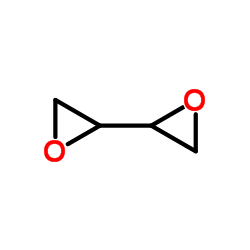2,2′-bioxirane

2,2′-bioxirane structure
|
Common Name | 2,2′-bioxirane | ||
|---|---|---|---|---|
| CAS Number | 1464-53-5 | Molecular Weight | 86.089 | |
| Density | 1.4±0.1 g/cm3 | Boiling Point | 138.0±0.0 °C at 760 mmHg | |
| Molecular Formula | C4H6O2 | Melting Point | 2-4 °C(lit.) | |
| MSDS | USA | Flash Point | 45.6±0.0 °C | |
| Symbol |




GHS02, GHS05, GHS06, GHS08 |
Signal Word | Danger | |
|
Modelling Fanconi anemia pathogenesis and therapeutics using integration-free patient-derived iPSCs.
Nat. Commun. 5 , 4330, (2014) Fanconi anaemia (FA) is a recessive disorder characterized by genomic instability, congenital abnormalities, cancer predisposition and bone marrow (BM) failure. However, the pathogenesis of FA is not fully understood partly due to the limitations of current d... |
|
|
DNA damage induced by three major metabolites of 1,3-butadiene in human hepatocyte L02 cells.
Mutat. Res. 747(2) , 240-5, (2012) 1,3-Butadiene (BD) is a carcinogenic air pollutant. Its bioactivation produces four major metabolites, i.e., 3,4-epoxy-1-butene (EB), 3,4-epoxy-1,2-butanediol (EBD), 1,2,3,4-diepoxybutane (DEB), and 3-butene-1,2-diol (BDD). Studies have been mostly focused on... |
|
|
Alkyltransferase-mediated toxicity of bis-electrophiles in mammalian cells.
Mutat. Res. 684(1-2) , 35-42, (2010) The primary function of O(6)-alkylguanine-DNA alkyltransferase (AGT) is to maintain genomic integrity in the face of damage by both endogenous and exogenous alkylating agents. However, paradoxically, bacterial and mammalian AGTs have been shown to increase cy... |
|
|
Protective effect of acetyl-l-carnitine and α-lipoic acid against the acute toxicity of diepoxybutane to human lymphocytes.
Toxicology 289(1) , 52-8, (2011) The biotransformation and oxidative stress may contribute to 1,2:3,4-diepoxybutane (DEB)-induced toxicity to human lymphocytes of Fanconi Anemia (FA) patients. Thus, the identification of putative inhibitors of bioactivation, as well as the determination of t... |
|
|
1,2:3,4-Diepoxybutane in blood of male B6C3F1 mice and male Sprague-Dawley rats exposed to 1,3-butadiene.
Toxicol. Lett. 207(3) , 286-90, (2011) The important industrial chemical 1,3-butadiene (BD; CAS Registry Number: 106-99-0) is a potent carcinogen in B6C3F1 mice and a weak one in Sprague-Dawley rats. This difference is mainly attributed to the species-specific burden by the metabolically formed 1,... |
|
|
Incidence of Fanconi anemia in children with congenital thumb anomalies referred for diepoxybutane testing.
J. Hand Surg. Am. 36(6) , 1052-7, (2011) Fanconi anemia (FA) is a rare genetic disorder of DNA repair that with near uniformity leads to bone marrow failure and resulting morbidity and mortality. Approximately 50% of FA patients are born with anomalies of the thumb or thumb and radius, and it has be... |
|
|
Fanconi anemia is characterized by delayed repair kinetics of DNA double-strand breaks.
Tohoku J. Exp. Med. 221(1) , 69-76, (2010) Among patients with bone marrow failure (BMF) syndrome, some are happened to have underlying Fanconi anemia (FA), a genetically heterogeneous disease, which is characterized by progressive pancytopenia and cancer susceptibility. Due to heterogeneous nature of... |
|
|
Diepoxybutane interstrand cross-links induce DNA bending.
Biochimie 94(2) , 574-7, (2012) The bifunctional alkylating agent 1,2,3,4-diepoxybutane (DEB) is thought to be a major contributor to the carcinogenicity of 1,3-butadiene, from which it is derived in vivo. DEB forms DNA interstrand cross-links primarily between distal deoxyguanosine residue... |
|
|
Normal red blood cells partially decrease diepoxybutane-induced chromosome breakage in cultured lymphocytes from Fanconi anaemia patients.
Cell Prolif. 43(6) , 573-8, (2010) Fanconi anaemia (FA) is a cancer-prone chromosome instability syndrome characterized by hypersensitivity to DNA cross-linking agents, such as diepoxybutane (DEB). Previous studies have shown that normal red blood cells (RBC) can protect cultured lymphocytes a... |
|
|
Genotoxicity of stereoisomers of 1,2,3,4-diepoxybutane in the gpt gene of Chinese hamster ovary AS52 cells.
Bull. Environ. Contam. Toxicol. 86(6) , 587-90, (2011) Three optical isomers of 1,2,3,4-diepoxybutane, S,S-, R,R-, and meso-diepoxybutane, are produced by the metabolic processing of carcinogenic 1,3-butadiene. Our previous studies suggested that the observed differences between the biological effects of diepoxyb... |